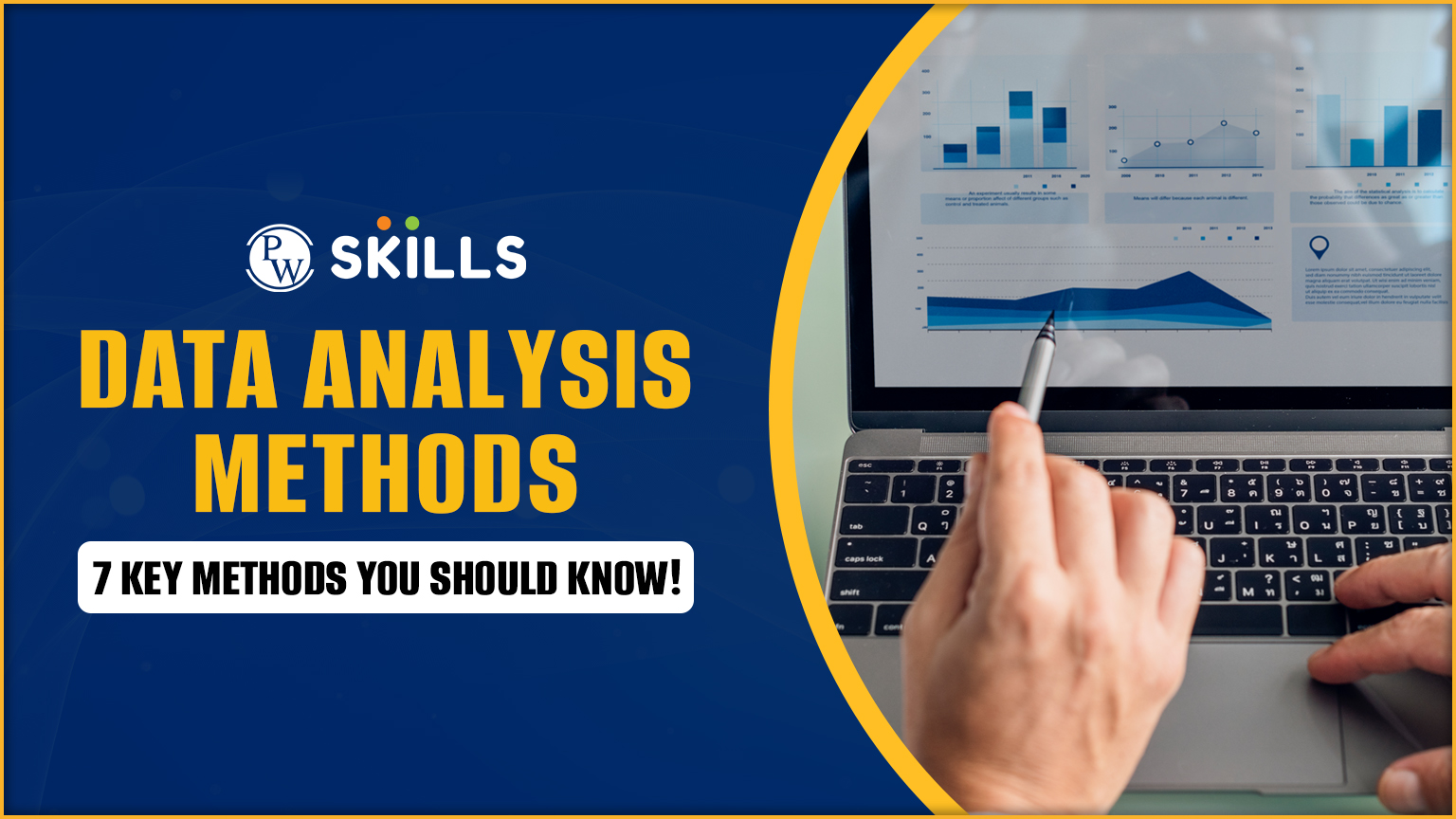Data analysis methods consist of various tools and techniques used to fetch data from vast and complex datasets. There are many methods that can help you extract useful information from data through inspecting, collecting, processing, and visualizing data. You can choose a specific method based on the type of data and accessibility.
Data analysis helps you stay competitive and informed and make data driven informed decisions. In this article, let us get familiar with some of the best data analysis methods used in the industry.
What is Data Analysis?
Data Analysis is a process used to inspect, collect, clean, process, transform, and model data to extract useful information from data and support decision making. It uses various tools and techniques to extract data based on understanding patterns, relationships, and trends in data.

It is used to inform decision making, reveal patterns, and gain insights within a dataset. For example, data analysis can be used to make personalized recommendations, medicinal research in the healthcare industry, etc.
How to Choose Data Analysis Methods?

Selecting the right data analysis methods depends on the nature of your data, and requirements.
1. Find your Objective
Get familiar with the problem you want to solve and the insights you need from the available dataset. Deep research for goals will help you know whether to use descriptive, diagnostic, predictive, or other data analysis methods.
2. Understand your Data
You must be familiar with the dataset you have, whether your objective is either qualitative or quantitative and whether the data is unstructured or structured. Make sure data is clean, consistent, and sufficient for analysis purpose.
For example, regression analysis methods use numeric and clean datasets while text analysis methods work for qualitative data.
3. Determine Type of Analysis
Now you must be aware of the type of analysis you have to perform on your data. You can either use descriptive to describe and summarize your data, predictive analytics to forecast future outcomes, and prescriptive analytics to recommend favorable outcomes based on data driven decisions.
4. Make use of Available Tools
Data analysis tools and techniques make your work more effective and productive at the same time. There are many data analysis tools available for various data analysis methods, such as Power BI, Tableau, Matplotlib, Excel, Python, and more.
5. Know Stakeholder’s Requirements
Make sure you give preference to the user’s needs and requirements from the analysis and then proceed with the project. Getting a clearer communication of their needs is better aligned with either descriptive, predictive, prescriptive, or other.
Also, ask whether they need detailed forecasts deep root analysis or just a simple approach based on the project.
6. Significance of Data Size
Keep very well informed about the size of data you want to work with, as it might involve multiple tests to ensure the method works with the data’s nature.
7 Data Analysis Methods For All Your Project Needs

With advancements in technologies,s the tools and frameworks available for analysis purposes are expanding. Let us learn some of the data analysis methods available for all types of data needs.
1. Regression Analysis
With Regression analysis, you can easily make predictions based on the latest trends in data. Regression analysis is a statistical approach used to identify the relationship between two or more variables. The main goal of regression analysis is to analyze and predict the relationship between variables.
There are many types of regression analysis, such as linear regression, multiple regression, and more. Regression analysis can be used to find future trends and outcomes based on the relationship.
Important Facts about Regression Analysis
- Regression analysis is a type of supervised machine learning analysis.
- It is used to find future trends or outcomes of the present analysis using the data available.
- Regression analysis is used for prediction and forecasting purposes in machine learning.
- The regression analysis technique depends on more independent variables.
2. Exploratory Data Analysis (EDA)
EDA data analysis methods are used to uncover hidden patterns, relationships, and anomalies in data. It is best for understanding the structure of new datasets and identifying the co relationship between two variables in a new dataset.
It uses Python frameworks and libraries like Matplotlib, R, etc. It is used in data science, data manipulation, visualization, predictive models, etc.
Important Facts about Exploratory Data Analysis (EDA)
- Exploratory Data analysis is used to identify and remove data outliers.
- It is used to identify trends in time and space.
- It is used to create and test hypothesis experiments
- It is to uncover patterns that relate to the target.
3. Causal Analysis
The Causal analysis data analysis methods are used to determine cause and effect relationships within data. It helps us evaluate the impact of one variable over another. It helps to identify the root cause of problems and understand the reason for the issues.
Important Facts about Causal Analysis
- Causal analysis has a wide range of applications in healthcare, economics, education, marketing, environmental policy, and more.
- Casual question analysis helps to improve our experience in daily life.
- It is used to address the symptoms that might arise in data analysis methods and make the effects less impactful.
4. Prescriptive Data Analysis Methods
The prescriptive data analysis methods are used to provide recommended actions in a particular situation and achieve desired outcomes based on the dataset. You can make decisions and optimise strategies with AI, data science, and machine learning algorithm tools.
Important Facts about Prescriptive Data Analysis Methods
- Prescriptive analysis is used to suggest a roadmap or strategy for product development.
- It can use unstructured and structured data.
- It uses advanced analytics techniques for predictions, prescribing and adapting to users needs.
5. Predictive Analysis
Predictive analysis uses historical data statistical models and machine learning algorithms to predict future outcomes and is best for forecasting behaviors and trends. It is widely used to make informed decisions, forecast trends, and minimize risks.
The primary goals of predictive analytics are to identify patterns and relationships in historical data and make accurate predictions about future events and outcomes.
Important Facts about Predictive Analytics Data Analysis Methods
- It is used to identify patterns and trends using historical data.
- It uses statistical measures like mean, median, and standard deviation, etc.
- It also uses data visualization models to enhance the understanding and presentation of data.
- It uses tools like Power BI, Tableau, interactive dashboards and advanced visualization.
6. Diagnostic Analytics
Diagnostic analytics focus on finding the causes behind the outcome and identifying the why behind data trends. It is used to understand the causes by identifying patterns and outliers that explain why certain processes occur.
Important Facts about Diagnostic Analytics Data Analysis Methods
- This data analysis method is used to find the cause behind a trend or output.
- It is used to identify the “why” behind data trends.
- For example: It is used to analyze why a product sells during a specific period.
- Python, SQL, and R are used for diagnostic analysis.
7. Data Mining
Data Mining is the process of extracting meaningful patterns, trends, and insights from large datasets. It involves mathematical, computational techniques, and statistical techniques to identify hidden relationships within the data. It is widely applied in various fields such as healthcare, marketing, finance and e-commerce.
Important Facts about Data Mining In Data Analysis Methods
- It involves automated methods for analysis and transforming data into usable insights.
- It utilizes machine learning models like regression, classification, time series forecasting, etc.
- It handles large volumes of data efficiently and integrates well with big data technologies.
- It cleanses and transforms raw data to ensure quality and consistency.
- It categorizes data into predefined labels using supervised learning.
Learn Data Analysis with PW Skills

Become proficient in data analysis and business analysis with the PW Skills Data Analysis Course. Get technical expertise and soft skills with in-depth tutorials, exercises, real-world projects and module-level assignments.
Get dedicated tutorials from dedicated mentors from industry led live sessions and recorded tutorials. Get certification from PW Skills after completing the course.
Data Analysis Methods FAQs
Q1. What are data analysis methods?
Ans: Descriptive analytics, diagnostic analysis, predictive analysis, prescriptive analysis and exploratory analysis methods are some of the examples of data analysis methods.
Q2. What tools and technologies are used commonly for data analysis?
Ans: Some of the common tools used in data analysis methods are Excel, Python, Tableau, SQL, SPSS, SAS, and more.
Q3. What is the role of visualisation in data analysis?
Ans: The role of visualization in data analysis are mentioned below.
Simplify complex datasets for better understanding.
Highlight patterns, trends, and anomalies.
Make data-driven insights accessible to a wider audience.
Improve decision-making by presenting actionable insights visually.
Q4. What are challenges in data analysis?
Ans: Some of the major challenges in data analysis are mentioned below.
Data quality issues like missing, duplicate or inconsistent data.
Managing and processing big data efficiently especially for large volumes of data.
Apply advanced methods like Machine Learning or deep learning.

